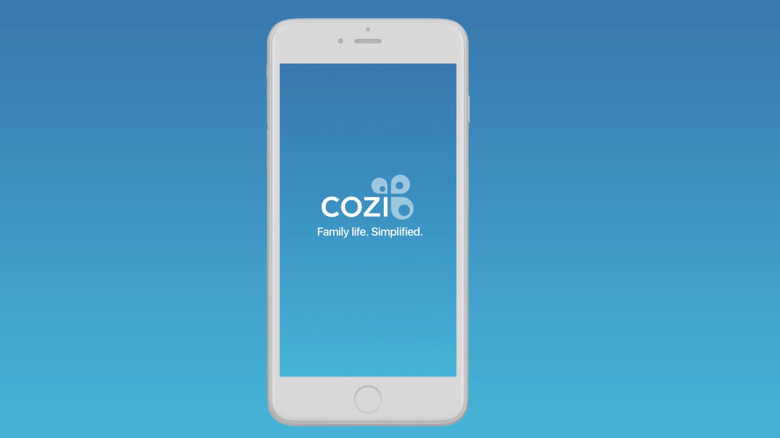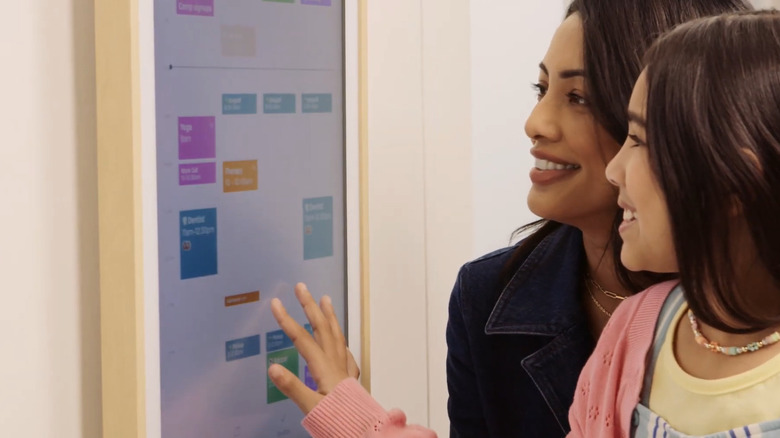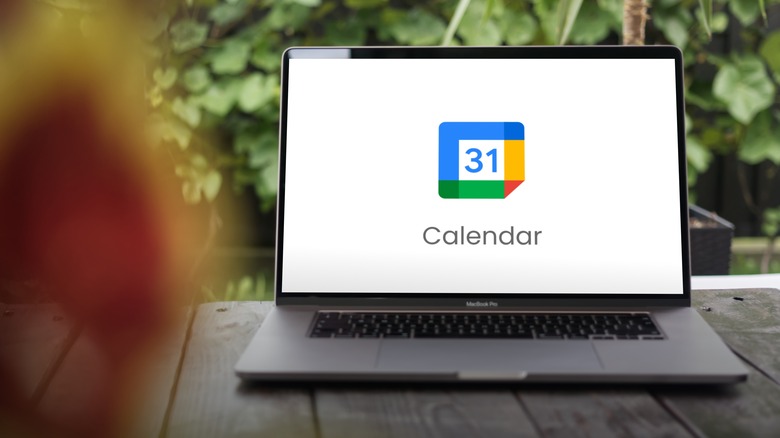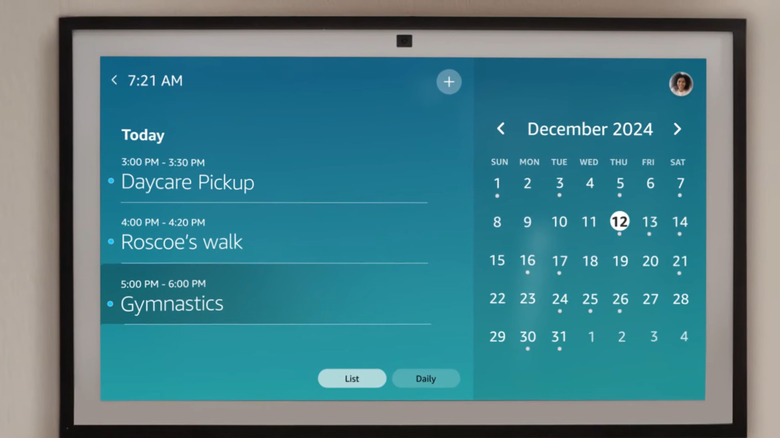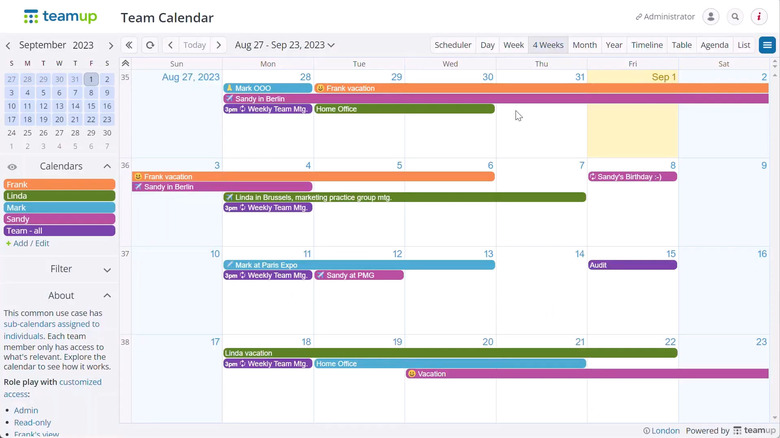14 Alternatives To The Skylight Calendar
We may receive a commission on purchases made from links.
Calendars are a time-tested tool that society couldn't live without. But just like countless other tools in the modern age, the calendar has seen quite the evolution. While there are plenty who still prefer flipping through a physical calendar, many others have transitioned to digital calendar options that do far more than letting you know the current day, week, and month. One such item that has gained popularity in recent years for its outstanding functionality is the Skylight Calendar, which goes above and beyond what even most digital calendars are capable of doing.
The Skylight Calendar is a smart display that offers a host of innovative functions that give users a dynamic level of control over their schedule. The Skylight's bold digital screen not only gives you the date, but lets you access unique features such as dinner planning, weather reports, chore charts, grocery lists, and more. Your Skylight can be connected to your smartphone through the accompanying mobile app and have access to it be shared with your family, making it an ideal gadget for busy parents looking to keep their families up to date on upcoming activities and events.
As useful as Skylight is, it's understandable to want to seek another digital calendar option. With the display itself costing between $150 and $600 alongside a $39 yearly subscription fee, it may not be the best suited to your situation. Whether you're seeking an option that costs less, is simpler to use, or contains a feature that's missing from Skylight, you'll find that there's no shortage to pick from, meaning you're bound to find something that will best suit your needs. Here are some Skylight alternatives that deserve your attention.
Mango Display
While Skylight gives you plenty of room to alter your schedule the way you'd like, there aren't as many ways to customize it to best work with your aesthetic. The display, no matter the size, will always come in the same default white frame and the screen offers little in the way of freedom in choosing what you want to see at any given time.
If this is an issue for you, then a Mango Display digital calendar may be up your alley. Unlike Skylight, there's no hardware involved with Mango. Rather, you can have the display put on any supported tablet or TV display, including iPads, Amazon Fire TVs, Samsung TVs, LG TVs, and more. While the $60 yearly fee for Mango Display does cost more than Skylight's $39 annual subscription, not having to purchase an extra piece of expensive hardware significantly cuts down on the upfront costs.
Perhaps the coolest thing about Mango Display is the way you can personalize it. Not only does setting it up take much less time than Skylight or similar devices that require an additional hardware component, but the program allows you to arrange your calendar, clock, background, weather, and other widgets around the screen to your liking. So if you want to have your calendar pushed more to the side to make room for the clock, or you want to use a Google photo as your background, no problem. Adding to this simplicity is the ability to access everything from one command center, as opposed to digging through various pages or apps.
Cozi
Skylight Calendar users may be familiar with Cozi, as it is one of the many digital calendars that auto-syncs with the platform. But to say that Cozi has little to offer on its own would be an untrue statement, as it has become a well-trusted digital calendar and scheduling program for many families in recent years.
While Cozi was founded in 2005, it has gained a new life in the aftermath of the COVID-19 pandemic. Users can attach up to 12 family members who can then access your shared calendars, to-do lists, and grocery lists. You can further customize the calendars and lists through notifications and color coding. Along with being free to download and use, Cozi has received acclaim from less tech-savvy parents for its simple, user-friendly interface and functionality.
Like Mango Display, there's no dedicated physical display for Cozi — it's an app for PCs and Macs. It is also available as a mobile app through the iOS App Store and Google Play, where it currently holds a 4.8 out of 5-star rating average on both platforms. One downside of the free version is that it does come with ads, which may be irritating for some. A more feature-filled, paid version called Cozi Gold can be obtained for $39 for an annual plan or $29.99 for a one-time year-long subscription.
Hearth Display
For many, the biggest draw to Skylight for many is the sizable display that comes with the program. Finding a digital calendar that comes with such a display and the same level of functionality isn't easy. However, that doesn't mean there are none, as is the case for Hearth Display, which in some ways even out does Skylight with some surprisingly advanced capabilities.
Hearth comes in the form of a 27-inch touchscreen display that can be mounted on your wall. Users can create an unlimited number of profiles and then access activities, meals, events, chores, and reminders through a simple, clean interface that's easy to view and navigate. Parents looking to build a good sense of independence and responsibility within their kids will find Hearth especially useful, as its bold display, user-friendly qualities, and engaging features such as personalized profile designs and habit streaks can prove encouraging to younger users.
Among Hearth Display's many features, such as screen timeout, weather updates, and the accompanying Hearth Companion app available on both the iOS App Store and Google Play, its most impressive is perhaps the Hearth Helper. The Hearth Helper is an AI assistant that seamlessly transfers the events listed on a photo of a physical calendar or forwarded email to your Hearth calendar. The biggest drawback to Hearth Helper is its cost. While the $9.99 per month membership is optional (this is the only way you can access Hearth Helper), the display itself costs $699 which, while not too surprising given its size and numerous features, will surely put a dent into the budgets of some families.
DAKboard
DAKboard is another versatile and innovative digital calendar that, like Skylight and Hearth, comes with a good-sized display that allows for a range of personal and professional applications. Unlike its competitors, however, buyers have a bit more room when it comes to finding a DAKboard that suits their aesthetic and financial needs.
DAKboard features a variety of 27-inch displays that come in styles from sleek and simple to rustic and wooden, as the company has licensed out its technology to be used by brands such as Smarty Mirrors, YaegerWoodWorks, Matter of Fractions, and more. They range in cost from $399.95 to $1,3999 which, while certainly pricey, does give you a range of options. This similarly applies to its membership fees, where you can pay between three yearly or monthly pay plans. There are even DIY options, as users who have an old monitor lying around can buy a much cheaper Raspberry Pi module to create their own functioning DAKboard screen. The crystal clear display allows for customizable calendar options, weather alerts, to-do lists, a digital photo frame, traffic updates, and more.
Along with the price concerns, DAKboard's biggest drawback is that it does not use a touchscreen by default, with the only way to currently enable the function being through displays powered by Raspberry Pi v3.41 and Orange Pi v103.41 or higher.
OurCal
While having a nice-sized display with a ton of features certainly has its benefits, many may not mind having their calendar on a smaller screen. Thankfully, there's no shortage of calendar apps that pack a lot of quality into a more compact package. Among these is the OurCal app, which ranks among the highest-rated calendar apps for a good reason.
Available on both the iOS App Store and Google Play for free, OurCal has garnered strong reviews on both platforms. The app is jam-packed with features made with multiple users in mind. The shared calendar allows users to invite whoever they desire and have them be synced to upcoming events and alerts. The calendar can be customized to suit a variety of social settings, from family activities to friend hangouts to romantic occasions and everything in between. Other special functions include private messaging, photo and document sharing, and the ability to sync with other online calendars from the likes of Google, Apple, Yahoo, and more.
Among the most notable qualities of OurCal is the tight security that comes with the service. The app comes with built-in end-to-end encryption technology to ensure that your calendars and events are only seen by those you intended to view them, aiding in privacy protection and organization. It may not be as flashy as some of the competitors, but for those seeking a simpler or cheaper option that still gets the job done, you may be pleasantly surprised with what OurCal has to offer.
Google Calendar
It's easy to forget what an integral part of our day-to-day lives that Google has become for so many of us. There's a good chance that even before reading this article, you've used one of Google's many services, whether it be Gmail, Google Docs, Google Sheets, Google Drive, and more. But with the myriad of digital calendar options to choose from nowadays, it's just as easy to take Google's own calendar and its robust set of functions for granted.
Google Calendar likely needs little introduction for most people. As the digital calendar that comes with your Google account, it is free to use across any laptop, tablet, or smartphone where you are signed in to Google. It allows you to map out and personalize your schedule with the ability to distinguish between your tasks and events through categories, color coding, specific notifications, and more. This gives you plenty of room to make distinctions between personal events, professional duties, and social gatherings without getting confused. Of course, you can also share your calendars and events with others, as well as sync it to other digital calendars.
Given Google's ownership of Android, it should come as no surprise that Google Calendar offers for features and functions for Android users. There's also a surprisingly steep learning curve to figuring out Google Calendar in terms of scheduling and notifications, so this may not be the best pick for families seeking a calendar that kids can get a grasp of right away. For those willing to put in the time to figure it out, however, there's a lot more to Google Calendar than meets the eye.
Amazon Echo Show
While the Skylight calendar has become an increasingly popular digital display, it's far from the first one around. Launched in June 2017, the Amazon Echo Show has been a consistently reliable and versatile tool for individuals and families alike, coming out three years before Skylight began producing calendars.
As part of Amazon's ever-expanding Echo family of smart speakers, the Echo Show is compatible with Alexa's voice controls, but that fancy display isn't just there to look pretty. Users can navigate through the Echo Show's touchscreen to stream movies and shows, play music, and display photos. It can perform advanced functions such as video calling (although its camera and microphone have some notable issues) and connecting to other smart home hubs to control your lights, blinds, and other appliances.
While the Echo Show's calendar capabilities may not be its main selling point, it nevertheless serves its purpose exceptionally well. The device's smart home hub gives you and others in your household easy access to the calendar, your schedule, and any upcoming events. The calendar can also be personalized, with the ability to customize your widgets and create shortcuts for efficient navigation, while also allowing you to sync your Google, Microsoft, or Apple calendars.
Apple Calendar
If you own an iPhone, iPad, MacBook, or other Apple product, you're more than likely familiar with the brand's extensive variety of shared apps and programs. But among the digital tools often overlooked by Apple users is the handy Calendar. This calendar may not be reinventing the wheel if you're seeking advanced options, but being able to share a singular calendar between your different Apple devices is sure to be a convenience for brand loyalists.
Presented with a clean, simple interface, Apple Calendar is easy to navigate and learn compared to the more tricky workarounds involved with understanding Google Calendar, making it one of the best alternatives to the platform. Scheduling events and setting reminders are quick and easy to do, as are sending out invitations, creating appointments, customizing your calendars with special colors and labels, and syncing with accounts from the likes of iCloud or Google. It can even perform some unexpected advanced functions such as document attachment and changing time zone for scheduling.
Given the efficiency of Apple's ecosystem, there are some neat ways that your calendar can integrate with your other apps. Along with being able to add a contact's birthdays or other events to your calendar, Siri will also be able to recognize events that show up in your Mail and add it to a special suggestions calendar, allowing for speedier organization. While maybe not the most attractive or interactive choice for families, there's no denying that the Apple Calendar does its job very well.
Outlook Calendar
While Skylight and displays like it are largely designed to appeal to family units, it may not be so effective for those who primarily use their calendars for work reasons. Sure, you can schedule events and see them clearly on Skylight, but it doesn't deliver much in the way of communicating between various parties or similarly advanced functions. The solution you're looking for could be sitting right in your pocket with Microsoft's Outlook Calendar.
Microsoft has been a dominating force in workplace and communication for decades, so it should come as no surprise that its signature calendar is as tight and efficient as they come. Along with being able to see the day, week, and month, the Outlook Calendar allows has an option to view the workweek. Here, you'll find a detailed breakdown of your upcoming meetings, projects, team check-ins, and more that occur between Monday and Friday. This lets you have more control over your work schedule while also helping you stay more organized by being able to create separate calendars for family, social, and personal activities.
Sharing the calendar with work colleagues is easy, especially if your account is linked to a work server. You can view and edit others' calendars if they've provided you with access to do so. Accessing the calendar to check your schedule is also simple, as you can hover over the calendar icon while looking at your Outlook email and quickly see the month and any upcoming events.
Calendly
Work teams look far different today than they have in the past. With more ways to effortlessly connect than ever before, there's a good chance that your workplace has employees, partners, and administration all around the globe. While this comes with numerous benefits for both employees and companies, it nevertheless comes with a host of challenges. For those seeking an advanced collaborative calendar, few options quite match the capabilities of Calendly.
You've more than likely come across Calendly for scheduling everything from doctor's appointments to Zoom calls. There's a good reason for that, as the platform offers a multitude of ways to stay on top of upcoming events while keeping team members and clients alike on the same page. Your team shares its availability and the app will automatically schedule activities based on that information. Cutting down on needless back and forth even more is the ability to send out polls to your team members regarding ideal days and times for meetings and other activities. For teams working internationally, Calendly even takes account of different time zones. Admins can go further with customizing meeting templates and looking at analytics.
With features such as this and the ability to integrate with hundreds of tools, including Slack, Google Chrome, Zoom, Microsoft Teams, and Outlook, it's easy to see why countless big and small companies have adopted the platform. While Calendly does offer a free subscription, it's rather limited. Its paid team subscriptions are between $10 and $16 per seat per month.
Fantastical
Fantastical has actually been around for some time, initially debuting in 2011 for Macs before becoming available on iPhone, iPad, and Apple Vision Pro, as well as recently becoming compatible with Windows. It's wild to think that this has been so slept on, as Fantastical packs quite the punch in terms of offerings.
Similar to Calendly, Fantastical allows users to share their schedules and availability with simplicity and efficiency. The Openings feature lets you share your available times with a client or colleague, with Fantastical keeping your existing scheduled events in mind. Openings can be easily sent through Apple communication platforms such as Mail and Messages for added convenience. Also, like Calendly, you can create polls for team members to elect preferable meeting times. Other functions such as RSVPS, event proposals, weather forecast, and conference call sync with Google Meet, Zoom, and Microsoft Teams are also available on Fantastical.
You can download Fantastical for free on your Apple device or Windows PC and try it out free of charge for 14 days. From there, you can subscribe to the service for either $4.75 a month for individuals, $7.50 a month for families, or $4.75 per month per user for businesses. A subscription also gets you Flexibits' other well-known platform Cardhop, a contact organization and integration system.
Zoho Calendar
Zoho has created a vast array of productivity solutions over the years for a wide variety of workplace scenarios, from solopreneurs to massive teams. No matter what your work environment looks like, however, having a quality calendar on hand is a must. Zoho Calendar is jam-packed with features and functions for any kind of situation and makes it easy to distinguish and organize your day-to-day tasks.
This is another platform that makes it easy to communicate with team members, no matter where you're located. Along with being able to see availabilities and time zones, you can also see if desired rooms are available at the time you want or choose what platform you want to have a video meeting on. However, given Zoho's extensive catalog of apps, you more than likely have what you need right there. For example, you can record your Zoho Meeting video call and then share the recording through the calendar's smart chat tab. The calendar itself is easy to navigate and customize, with the ability to go between daily, weekly, monthly, 3-day, and agenda views.
Perhaps the best part of Zoho Calendar for many is that it can be downloaded, either from its website, the iOS App Store, or Google Play, and used for free.
Teamup Calendar
As impressive as many team calendars truly are, there's no denying that they can get a bit hectic. This may be fine for some, but if you're seeking a dedicated team calendar tool that replicates that colorful presentation and relative simplicity of Skylight, then it may be worth giving Teamup Calendar a try.
Whereas many calendars let more or less one person decide how everything will be organized, Teamup gives each user a great range of flexibility with how they want their calendar to appear while remaining connected. This is thanks in large part to the sub-calendar feature for each team member, allowing them to be easily identified through a specific coded color and customize how they view their schedule. The calendar can be viewed through traditional means such as day, week, and month but can also be shown to reflect to-do lists and agendas. You can even customize the display itself by having your company or brand logo be used for the header. It's also easy to share Teamup with others, as users can send calendar URLs even with those who don't have a Teamup account.
Teamup is available on the App Store and Google Play. From there, you can either choose to subscribe to the service for free or opt into its paid options that range from $10 to $105 a month.
Calendar
At first glance, Calendar may seem like an especially generic brand. But behind that overly simplistic name is a program that truly deserves a place on this list thanks to its streamlined yet versatile approach to scheduling, organization, syncing, and more.
When it comes to scheduling events and meetings, Calendar offers plenty of ways to customize. Users can share meeting links through email or text that are specialized for different events. When scheduling for teams, various host options can be picked, including a singular admin, multiple hosts, and even switching between different team members. Connecting Calendar to your other work tools is also a major draw for the platform, from the ability to have it as a Chrome extension to integrating it with Zoom, Gmail, Microsoft Teams, and more. Calendar gives users further ways to personalize their schedules depending on their situation, from freelancers balancing various gigs to bosses leading large teams, by making it easy to separate different calendars from one another. It is continuing to develop advanced functions, such as an analytics feature to help teams better assess their productivity.
This is another platform that's easy to download on to practically any device, being available to download for Macs and PCs as well as mobile phones and tablets through the App Store and Google Play. Subscription prices range from free to $12 per user per month, as well as a custom option for enterprises.


